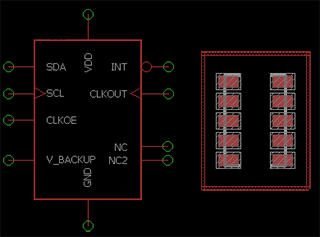Meeting the challenges of wearable PCB design
10 Nov 2015
EMILY LAWRIE - MARKETING
The latest technology trend spanning the medical, fitness, and mass-consumer markets - wearable technology looks set to provide innovation in health-monitoring, research and fashion.
There are technical challenges with designing PCBs in wearable devices comes at price. Here we lay out some of the most common challenges faced by the wearables designer and offer some help on how to combat the potential problems.

Challenges of PCB design for wearable products
Size and shape
By their very nature wearables are tiny. What’s more they’re packed full of functionality. This can easily become a major headache for a design engineer. Even if you’re working with pre-built modules, what you gain in design time you can often lose in board routing flexibility. On top of size comes shape: it’s incredibly rare that a wearables board is a rigid rectangle, much more common are thin multi-layer boards with curved outlines, tightly packed to fit within beautifully designed product casing.
How to tackle it:
Use your board space as efficiently as possible by reducing the size of the peripheral electronic components wherever you can. By using clever design techniques tracks can often be made to navigate the most efficient route, but be careful with intricate routing over multiple board layers. Check out these useful PCB design guidelines .
Above all, do not depend on the auto-router system for this type of work. PCB Design software is good but nothing beats getting an engineer’s eye on the problem.
Board Material
Added to the complexity of designing small, intricate boards, some wearables require board designers to work with unusual materials including, fabric, plastic, flexi-rigid material and mesh. These materials require specialist knowledge and in some instances original research in order to find the best way of working with them. Many groups including the likes of Google and Toshiba are currently conducting research into truly wearable circuits, the technology behind which would allow fabric-based wearables to penetrate the mass-consumer market.
How to tackle it:
If your application calls for an unusual material board, but you have no experience with designing these types of boards, it is highly recommended to seek specialist advice. There are several research groups working within these areas, many of whom are active in publishing their latest findings and this research can be incredibly useful when planning a route forward. Here are some useful links to current wearables research groups around the world:
- https://www.holstcentre.com/
- https://www.sussex.ac.uk/strc/
- https://www.wearable-technologies.com/
Power
It’s inherent in the product type: wearable technology usually relies on batteries or energy harvesting to power them through the day. This means that wearable designs come with strict power consumption budgets and engineers need to think twice before implementing even the smallest of power extravagances.
How to tackle it:
Plan for power. You can approach the problem with an energy budget, broken into tasks or power-consumption allowances allocated to each circuit block. By basing these allowances on each function within the system, you can often find more flexibility when it comes to specifying the power consumption of the components you need. Speak to your component supplier’s sales team and explain the problems you have. Often they will have recommendations for alternative parts you could use to help with the power-consumption problem.
Connectivity
Connectivity is at the core of most wearables products and so modules that provide connectivity through Bluetooth, wifi, and other protocols are essential parts of the wearables design. This means the engineer needs to find space on their board to include these modules or RF circuits.
How to tackle it:
Thankfully with the IoT just around the corner more and more off-the-shelf connectivity products are becoming available that are small enough to be suitable for wearable products. Tiny modules and RF components, designed specifically for wearable products are now being offered that cover almost all connectivity protocols.
To take some of the challenge out of choosing peripheral components for your wearable PCB design we’ve selected a collection of components including crystals, oscillators, TCXOs, RTC modules and SAW filters, all especially suited to wearables applications.
Browse our range of components suitable for wearable projects here

Body-based challenges for wearable PCB design
Antenna design
The real knotty problem with wearable PCB design comes in the form of designing antennas for use so close to the human body. The human body is extremely lossy and this poses a big problem for design engineers who need to preserve signal strength when transmitting and receiving near to the body.
How to tackle it:
In order to preserve signal strength electromagnetic fields should be concentrated away from the body to the maximum possible extent. This will often require specialist design and the use of components such as low-noise-amplifiers (LNAs) that can help to mitigate the problem by amplifying signals near to the body.
Humidity
As well as being exceptionally lossy the human body also provides a level of humidity that can wreak havoc with sensitive systems. In particular high impedance circuits (for example circuits involving tuning-fork crystals) are not tolerant of humidity. This poses a protection issue for the engineer: how to ensure your lovingly-crafted design doesn’t fail due to the environment it has to work in.
How to tackle it:
Ideally the product casing or packaging needs to be hermetically sealed in order to resist humidity and prevent it penetrating to the product at all. In circumstances where hermetically sealed casing is impossible to fully achieve, a conformal coating can be applied to the board. This coating acts in a similar way to varnish to stop moisture penetrating to delicate components. Prevention of leakage currents is especially important in wearable designs where the operating current can be down in the nA region.
Find the Golledge wearables component collection within our CADSoft Eagle Part Library
To m ake life a little easier for the design engineer we’ve put together a library of parts we specially recommend for new designs. Within the Golledge part library you can find schematics, package drawings and further product details to help with designing-in Golledge components. All of our wearables parts are available within the library, along with other industry favourites from our product range.
ake life a little easier for the design engineer we’ve put together a library of parts we specially recommend for new designs. Within the Golledge part library you can find schematics, package drawings and further product details to help with designing-in Golledge components. All of our wearables parts are available within the library, along with other industry favourites from our product range.
Why Eagle?
Eagle's accessibility, full tutorials and free option (available here) make it a great tool for beginning and experienced engineers alike.
Download the Golledge CadSoft Eagle Part Library here
Or check out the Golledge library in Eagle's library database
Enhance Your Wearable PCB Design with Expert Guidance from Golledge
Navigating the complexities of wearable tech PCB design can be daunting, but you don't have to face these challenges alone. At Golledge, we understand the unique requirements and intricacies of wearable technology. Our team of experts is here to help you overcome any obstacles you may encounter.
From ensuring optimal signal integrity to maximising space efficiency and minimising power consumption, our comprehensive range of frequency control products are specifically designed to meet the demands of wearable PCB design. Whether you're developing a fitness tracker, a smartwatch, or a medical wearables, we have the expertise and resources to support you at every stage of the design process.
By partnering with Golledge, you gain access to our extensive industry experience, technical knowledge, and personalised support, empowering you to achieve your design objectives efficiently and effectively. Our team is committed to providing you with tailored solutions that address your unique challenges and help you deliver innovative and reliable wearable devices to market.
Get in touch with us today to learn how our expertise can help you overcome challenges, optimise your design, and bring your wearable technology to life. Together, we can turn your vision into reality and revolutionise the world of wearable electronics.
